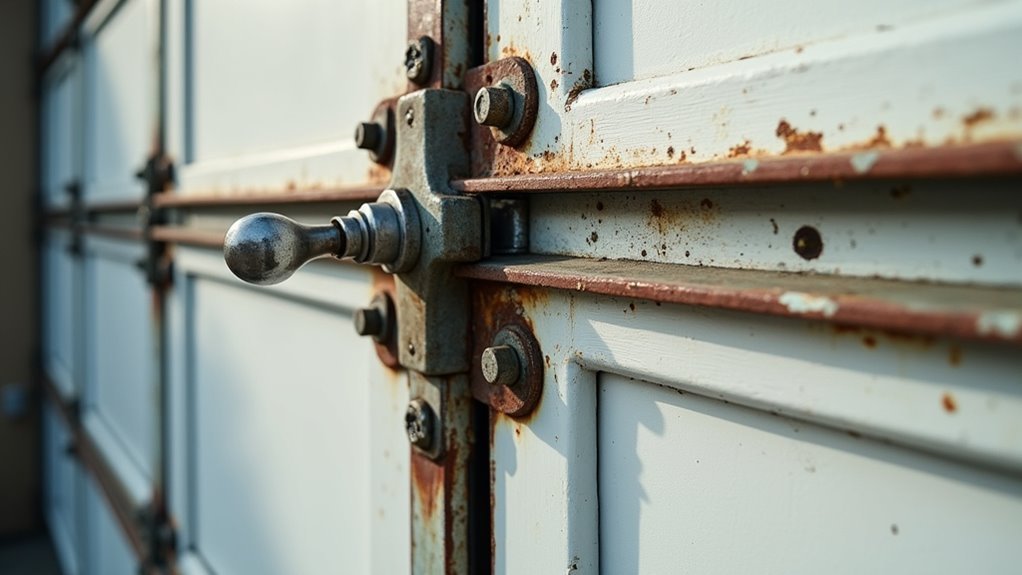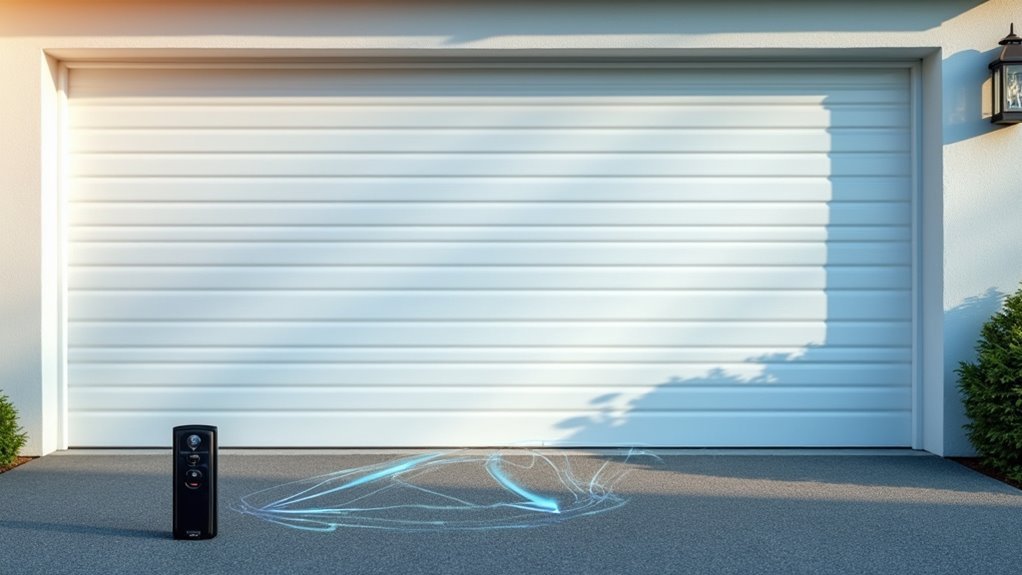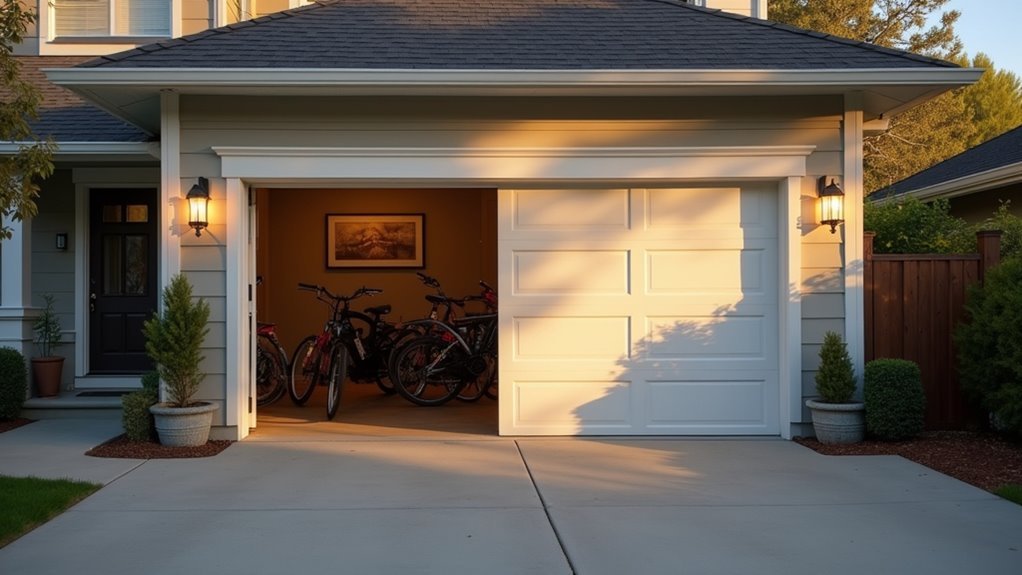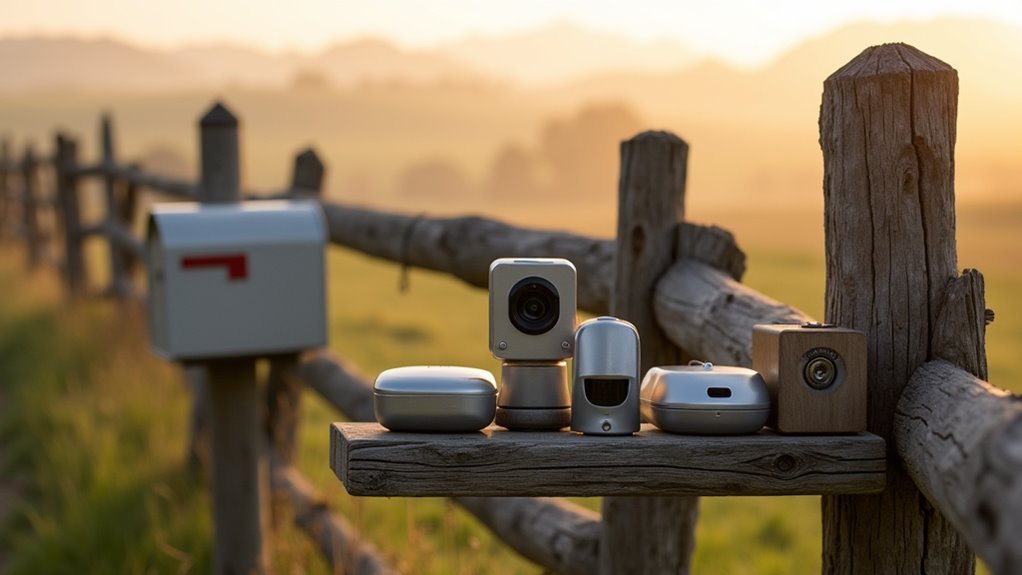Your garage door isn’t just an entry point—it’s a potential gateway for thieves who’ve mastered the art of intercepting weak signals and outdated technology. You might think that basic remote control is enough protection, but modern criminals can easily exploit vulnerable connections to gain access to your home within seconds. The security gap you’re not addressing could be the very weakness that compromises your family’s safety and your property’s protection.
Understanding Garage Door Vulnerability Points

While your home’s front and back doors likely feature multiple locks and reinforced frames, your garage door often stands as the weakest link in your property’s security chain.
Criminals frequently target these entry points because they understand the vulnerabilities.
Your emergency release mechanism poses a significant risk. Intruders can fish for the release cord from outside, disconnecting your door from its opener.
Older garage door models using fixed-code technology are particularly vulnerable to hacking, as thieves can capture and retransmit these codes easily.
You’re also creating risk by leaving remotes in your vehicle. This common mistake gives criminals direct access to your home.
Modern garage door models with rolling code technology and enhanced security features offer better protection, but you’ll need additional physical barriers like track locks for thorough security.
Rolling Code Technology Protection
Rolling code technology transforms your garage door opener into a dynamic security system that generates a new access code every time you press your remote.
This advanced protection offers over 100 billion possible code combinations, making it nearly impossible for hackers to intercept and reuse your access codes.
Unlike older garage door systems that used identical, fixed codes vulnerable to code grabbers, rolling code technology creates a synchronized random code between your remote and opener with each use.
Rolling code technology generates fresh synchronized codes with every use, replacing vulnerable fixed codes that hackers could easily intercept and exploit.
Even if someone captures your transmission, they can’t gain unauthorized access because that specific code becomes immediately obsolete.
This evolution from static to dynamic security represents a vital upgrade for your home’s protection, effectively eliminating the vulnerability that plagued traditional garage door systems and providing robust defense against potential break-ins.
Encryption Methods for Signal Security

You’ll want to understand how encryption methods work alongside rolling code technology to create an impenetrable security barrier for your garage door system.
These advanced encryption standards scramble your remote’s signal into an unreadable format that only your specific opener can decipher, making it nearly impossible for hackers to intercept or duplicate.
This encryption process also helps prevent signal interference from other devices, ensuring your garage door responds only to your legitimate remote commands.
Rolling Code Technology
Because traditional garage door openers relied on fixed codes that hackers could easily intercept and duplicate, manufacturers developed rolling code technology to eliminate this critical vulnerability.
This advanced system generates a unique access code every time you press your remote, making it virtually impossible for criminals to capture and reuse your signal.
Rolling code technology creates over 100 billion possible combinations, dramatically reducing unauthorized access risks. Each button press sends a completely different encrypted signal that your opener recognizes and validates.
Unlike older systems where intercepted codes remained useful indefinitely, rolling codes become worthless immediately after use.
Modern security systems integrate this technology with sophisticated encryption methods that scramble transmitted signals, preventing unauthorized devices from understanding or duplicating your access commands, ensuring your garage remains secure.
Signal Interference Prevention
While rolling codes provide excellent protection against code duplication, encryption methods add another essential layer that shields your garage door signals from interference and unauthorized access. When you use your garage door remote, encryption scrambles the signal, making it unreadable to unauthorized devices. Only your corresponding opener can decipher these encrypted signals, preventing hackers from duplicating or manipulating them.
| Security Feature | Protection Level | Remote Access Safety |
|---|---|---|
| Basic Fixed Code | Low | Vulnerable |
| Rolling Code | High | Moderate |
| Encryption + Rolling Code | Maximum | Secure |
| No Security | None | Highly Vulnerable |
Modern systems combine encryption with rolling code technology, generating new random access codes with each use. This robust defense guarantees you’ll maintain complete control over your garage door operations while protecting against sophisticated interception methods.
Advanced Encryption Standards
Advanced Encryption Standard (AES) technology transforms your garage door’s communication into an impenetrable digital fortress, using complex mathematical algorithms that scramble signals into seemingly random data streams.
This encryption guarantees only your corresponding opener can decipher transmitted commands, eliminating any security weak spot that hackers might exploit.
Modern automatic garage door openers implement sophisticated encryption protocols alongside rolling code technology, creating multiple defensive layers against unauthorized access.
When you press your remote, the encrypted signal becomes unreadable to intercepting devices, preventing signal duplication and replay attacks.
The robust processing power required for high-quality encryption means only sophisticated equipment could attempt cracking these signals, making unauthorized access nearly impossible.
You’ll benefit from this multi-layered security approach that greatly reduces breach risks.
Wi-Fi Vs Bluetooth Connectivity Options

When you’re choosing between Wi-Fi and Bluetooth connectivity for your garage door opener, you’ll face a fundamental trade-off between convenience and security.
Wi-Fi connectivity enables remote control from anywhere with internet access, providing real-time alerts and activity logs on your smartphone. You’ll enjoy smart home integration and automation features, but you’ll consume more power and depend on stable internet connections.
Bluetooth connectivity offers enhanced physical security since you must be within 30 feet to operate your garage door. This localized approach provides:
- Independent operation – Functions without internet access, ensuring reliability during outages
- Lower power consumption – Extends battery life in battery-operated systems
- Enhanced security – Physical proximity requirement adds protective barriers
However, you’ll sacrifice remote monitoring capabilities and extensive smart home integrations with Bluetooth options.
Smart Home Integration Benefits
Integrating your garage door with smart home systems transforms an isolated device into a central component of your home’s security and automation network.
You’ll gain remote control through smartphone apps, letting you operate and monitor your door from anywhere. Real-time notifications alert you when the door’s left open, preventing security vulnerabilities.
Your smart home setup becomes more extensive when you connect garage door openers with security cameras and motion sensors. You can create automated schedules that close the door at specific times, eliminating forgotten openings.
Vacation mode temporarily disables remote access while you’re away, blocking unauthorized entry attempts.
These integrated systems provide layered security protection while offering convenient automation features that adapt to your daily routines and lifestyle needs.
Remote Monitoring and Control Features
Remote monitoring transforms how you’ll interact with your garage door by delivering instant status updates directly to your smartphone.
You’ll always know whether your door is open or closed, no matter where you are. This real-time awareness eliminates uncertainty and provides peace of mind during your daily routine.
When you control your garage door remotely, you gain three essential capabilities:
- Real-time notifications – Receive immediate alerts about door status changes and security events
- Activity logging – Track who accessed your garage and when for enhanced accountability
- Smartphone operation – Open or close your door from anywhere using your mobile device
Remote monitoring also includes vacation mode, which temporarily disables remote access during extended trips.
Battery backup systems guarantee you’ll maintain full functionality even during power outages, keeping your garage secure and accessible.
Vacation Mode Security Settings
You can enhance your garage door’s security during extended absences by configuring vacation mode settings that temporarily disable remote access while keeping your wall control functional.
Smart lock scheduling allows you to set specific timeframes when remote controls won’t work, giving you precise control over access periods.
Track lock installation provides an additional physical security layer by preventing the door from being forced open even if someone bypasses the electronic controls.
Smart Lock Scheduling
When you’re planning extended trips away from home, smart lock scheduling transforms your garage door into an automated security system that works around the clock. This feature lets you program specific times for your smart garage door to lock and release automatically, eliminating manual intervention while maintaining top-tier security.
Here’s how smart lock scheduling helps secure your garage during extended absences:
- Automated locking schedules match your travel itinerary, automatically engaging security protocols when you leave and disabling them upon return.
- Real-time notifications alert you instantly when someone accesses your garage, letting you monitor activity from anywhere.
- Wall control accessibility guarantees trusted individuals can still enter manually while remote access remains completely disabled for maximum protection.
Track Lock Installation
Secure your garage door against manual lifting attempts by installing a track lock—a straightforward and affordable security upgrade that costs around $15 and takes just minutes to implement.
You’ll strengthen your garage door security by securing bolts directly onto the track, creating a physical barrier that prevents unauthorized manual entry during extended absences or vacations.
Before installation, consider temperature conditions since metal components can become brittle in freezing weather.
Combine your track lock with vacation mode settings on your opener to disable remote controls temporarily, creating a dual-layer security system.
Regular maintenance checks guarantee both systems function reliably when you need them most, providing peace of mind during long trips away from home.
Battery Backup for Continuous Protection
Power outages shouldn’t leave you stranded outside your garage, which is why battery backup systems have become essential components of modern garage door security.
These systems guarantee your opener continues functioning when electricity fails, preventing lockouts during emergencies.
Most modern garage door openers include built-in battery backup, eliminating the need for additional components.
You’ll maintain continuous access and security even during unexpected power disruptions.
Benefits of battery backup for home security:
- Emergency Access – Operate your garage door during power outages for several opening cycles
- Security Continuity – Support manual security measures when electricity is unavailable
- Peace of Mind – Reliable operation protects against being locked out unexpectedly
Investing in battery backup enhances your overall home security strategy by guaranteeing uninterrupted garage access.
Multi-Factor Authentication Setup
You’ll want to layer multiple authentication methods to create an impenetrable barrier around your garage door system.
Start by combining traditional passwords with biometric scanners that read your fingerprint or facial features, then add rolling code technology that generates unique access codes for each entry attempt.
Complete your security fortress by integrating app-based verification layers that send real-time alerts and require smartphone confirmation before any garage door operation.
Password Plus Biometric Access
When you combine password protection with biometric verification, you’re creating a fortress-like security system for your garage door that’s nearly impossible for intruders to breach.
This dual-layer approach guarantees that even if someone discovers your password, they still can’t gain access to your garage without your unique biological markers.
Modern smart garage door lock systems make implementing this security straightforward:
- Fingerprint Recognition – Your fingerprint serves as an unchangeable key that can’t be duplicated or shared.
- Mobile App Integration – Set up both password and biometric requirements through manufacturer apps.
- Keypad Configuration – Program dedicated keypads to require both authentication methods before granting entry.
This multi-factor system aligns with cybersecurity best practices, dramatically reducing break-in risks while maintaining convenient access to your garage.
Rolling Code Technology
While password and biometric systems create robust physical barriers, rolling code technology adds an essential layer of protection against digital interception attacks. Your garage door remote generates a completely new security code each time you press the button, making it impossible for thieves to reuse stolen signals.
This system produces over 100 billion unique combinations, effectively neutralizing code-grabbing devices that criminals use to break into homes. Modern garage door openers automatically sync these changing codes between your remote and the opener itself.
Unlike older fixed-code systems that hackers easily compromised, rolling code technology guarantees continuous protection. You’ll gain significant peace of mind knowing your garage remains secure against unauthorized digital access attempts, dramatically reducing break-in risks.
App-Based Security Layers
How can you further bulletproof your garage door’s digital defenses? Multi-factor authentication (MFA) transforms your smart garage door into a digital fortress.
You’ll need both your password and a secondary verification method—like a text message or app notification—making unauthorized access nearly impossible.
Most smart garage door systems let you enable MFA through their mobile apps, ensuring only authorized users control remote access.
Here’s what MFA provides:
- Dual-layer protection requiring both password and secondary authentication
- Real-time monitoring with alerts for failed login attempts
- Future-proof security through continuous app updates against evolving threats
Preventing Signal Interception Attacks
Although traditional fixed code systems made garage doors convenient to operate, they’ve created a serious vulnerability that modern thieves exploit with alarming ease. Signal interception attacks target these fixed codes, allowing criminals to replicate your garage door’s access signal and gain unauthorized entry to your home.
| Security Feature | Fixed Code Systems | Modern Rolling Code |
|---|---|---|
| Code Variation | Single static code | 100+ billion combinations |
| Vulnerability Level | High risk | Extremely low risk |
| Signal Protection | None | Encrypted transmission |
Rolling code technology generates a new access code with each use, making interception nearly impossible. Combined with encryption, which scrambles signals between your remote and opener, you’ll have multiple security layers protecting your garage. Regularly updating these features guarantees maximum protection against evolving theft techniques.
Secure Network Configuration Requirements
Modern garage door openers that connect to your home’s Wi-Fi network require careful configuration to maintain the security benefits you’ve gained from rolling code technology.
Your smart garage door opener needs proper network protection to prevent unauthorized access and hacking attempts.
Without proper network security measures, your smart garage door opener becomes a vulnerable entry point for cybercriminals targeting your home.
To establish a secure network environment for your smart garage door opener, follow these essential requirements:
- Use WPA3 encryption – Connect your opener only to networks with WPA3, the highest security standard available for wireless communications.
- Create a separate IoT network – Isolate your garage door opener on a dedicated network to limit exposure from other connected devices in your home.
- Disable unused features – Turn off remote access and temporary codes when not needed to reduce potential attack vectors.
Regular Security Updates and Patches
Even with proper network configuration, your smart garage door opener remains vulnerable without current firmware. You must install regular security updates to protect against emerging threats and hacking attempts.
Manufacturers release firmware updates periodically that improve encryption methods and rolling code technology, greatly strengthening your system’s communication signals.
Outdated systems become prime targets for hackers exploiting known vulnerabilities. You should regularly check your manufacturer’s website or app for available updates and follow installation instructions promptly.
Establishing a schedule for updates guarantees you’re always equipped with the latest security features and technological advancements.
Don’t leave your garage door susceptible to exploits—staying current with patches maintains ideal protection levels and prevents unauthorized access to your home.
Emergency Access Override Protection
While smart technology enhances your garage door’s security, the manual emergency release mechanism can become your system’s weakest link if left unprotected.
Burglars exploit this emergency access vulnerability through “fishing” – creating gaps at your door’s top to reach the release cord with wire tools.
Protect your garage door security with these essential measures:
- Install a lock shield – This device blocks fishing attempts by obstructing access to the emergency release cord.
- Secure the cord with zip ties – Attach the release handle to the track to prevent easy manipulation while maintaining emergency functionality.
- Regular maintenance checks – Inspect your emergency access points monthly to verify security features remain intact and effective.
These simple modifications greatly reduce unauthorized entry risks while preserving legitimate emergency access.
Professional Installation Vs DIY Security Setup
You’ll need to weigh the upfront costs of professional installation against potential long-term expenses from DIY mistakes that could compromise your garage door’s security.
Consider whether you’ve got the technical expertise to properly integrate rolling code technology and smart monitoring systems, as improper setup often leads to vulnerabilities.
Don’t overlook the safety risks involved—incorrect installation can create security gaps that leave your home exposed to break-ins.
Cost Analysis Comparison
Two distinct pricing paths emerge when securing your garage door: professional installation and DIY implementation. Your cost analysis reveals significant differences between these approaches.
Professional installation typically ranges from $150 to $500, depending on complexity and equipment. While this upfront investment seems substantial, you’ll receive warranties, guarantees, and proper installation assurance.
DIY setups often cost under $100 with basic tools and materials, delivering up to 75% savings compared to professional services.
Consider these key cost factors:
- Initial Investment – DIY saves money upfront but requires your time and skills.
- Long-term Value – Professional installation includes warranties and potential service options.
- Risk Assessment – Improper DIY work could lead to costly future repairs.
Your choice depends on balancing immediate savings against long-term security and maintenance considerations.
Technical Skill Requirements
Beyond the financial considerations, your technical abilities play a significant role in determining whether professional installation or DIY setup makes sense for your garage door security system.
If you possess intermediate technical skills and understand electrical systems and garage door mechanics, you can successfully install most smart garage door systems using manufacturer-provided guides. However, improper DIY installations create security vulnerabilities that intruders might exploit.
Professional technicians guarantee compliance with safety standards and eliminate installation errors that could compromise your system’s functionality. They’ll provide expert advice tailored to your specific garage configuration, offering peace of mind that your security setup is optimized.
Whether you choose DIY or professional installation, strictly following manufacturer specifications is vital for maintaining robust security and preventing potential malfunctions.
Safety Risk Factors
While professional installation considerably reduces security vulnerabilities, DIY setups often create dangerous blind spots that compromise your garage’s protection.
When you attempt to secure your garage door without expert knowledge, you’re risking critical oversights that intruders can exploit.
Professional security systems installation addresses vulnerabilities you might miss:
- Comprehensive entry point coverage – Experts identify and secure all potential access points, including windows and side doors that DIY approaches often overlook.
- Advanced technology integration – Rolling code technology and battery backup systems require proper configuration to prevent unauthorized access during power outages.
- Layout-specific reinforcement – Professional assessment reveals unique garage vulnerabilities and recommends tailored solutions like door reinforcement.
Statistics demonstrate homes with professionally installed garage door security systems are 300% less likely to experience break-ins compared to unprotected properties.
Frequently Asked Questions
How Do I Stop Thieves From Opening My Garage Door?
You’ll stop thieves by installing a lock shield over the release cord, upgrading to rolling code technology, using track locks, keeping remotes on your keychain, and regularly maintaining all security features.
Why Are Restraining Cables Needed for Garage Doors?
You need restraining cables because they prevent your garage door from falling off its track if springs fail. They’re made of high-strength steel and keep you safe from injury.
How Do I Make My Garage Door More Secure?
You’ll boost your garage door’s security by upgrading to rolling code technology, installing lock shields, adding smart monitors for alerts, reinforcing with deadbolts, and maintaining all components regularly.
How to Secure Your Garage From Burglars?
You’ll secure your garage from burglars by installing lock shields, using rolling code openers, reinforcing entry doors with deadbolts, adding track locks, and installing motion sensor lights for visibility and deterrence.





Leave a Reply